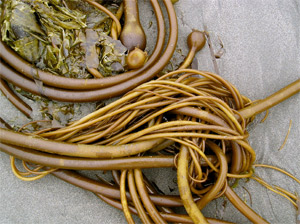Rocky shore plants & algae
Seaweeds can make tidepooling difficult or dangerous because they are often slippery. However seaweeds are remarkably adapted because they can dry out at low tide and rehydrate at high tide a couple of times each day! When out in the intertidal be sure to notice the facinating zonation created by these algae and plants. The flat wet kelps provide a protected habitat for many creatures living in the intertidal at low tide. Feel free to move the kelp blades around, but remember to put them back when you are done! The diversity of seaweed far exceeds the following list. Be sure to check out additional field guides for more information.
Phylum Phaeophyta – brown seaweeds
Bull kelp
Size: Up to 100 feet long, this kelp is one of the largest in the world, and it can grow more than 5” in a day.
Lifespan: Most of these plants rarely live longer than a year, and usually do not survive the harsh winter storms of the Pacific Northwest.
Habitat: This kelp grows in the subtidal zone, but is commonly found washed ashore on sandy beaches or in the rocky intertidal.
Appearance: A long, hollow stem with a bulbous float with four flat blades is connected to the ocean floor by its amazingly strong holdfast.
Human use : This kelp has provided many uses for people of the past and present. Historically, people cut off the bulbous end to be dried and then used as a vessel to carry water. This species is edible; pickling is one way people have chosen to eat it. Dried pieces have often become part of wind chimes or other ornamental objects. It can also be a great jump rope.
Rockweed
Appearance: leaves 3 1/4” or 8cm tall. They have flattened stems with swollen ends and are light tan to olive in color.
Habitat: It grows on rocks in the high intertidal instead of stretching up from the ocean’s floor like its much larger cousin, bull kelp.
Ecology: Rockweed is the Northwest’s most commonly seen algae. The button-like holdfast keeps the algae from drifting away from its rocky substrate. Rockweed holds moisture extremely well so it can withstand drastic changes in temperature. Tannins, a chemical released by the algae, prevent small inhabitants from using the moist greenery as shelter against the hot sun. The small bumps on the swollen ends of rockweed are actually sites of reproductive gametes. These bulbs of water are only created when the time is just right. It chooses the perfect time at low tide to release the eggs and sperm into the calm water. The developing plant must eventually attach to a rock and grow a new holdfast.
Phylum Rhodophyta – red seaweeds
Laver or nori
Porphyra perforata
Appearance: About 12” long, the wide blades are very thin and delicate and are held on byb a tiny disc shaped holdfast. Iridescent purple or purple green.
Ecology: This red seaweed catches the sunlight beautifully on a clear day showcasing its iridescent qualities. This plant dries up quickly in the high tide zones, but can easily re-hydrate once the tide comes back up. This is the same plant used to make sushi nori. It is baked into sheets, and is cultivated worldwide as food. Pick a small piece and taste it!
Coraline algae
 Corallina sp. Litholamnion sp. (encrusting)
Corallina sp. Litholamnion sp. (encrusting)
Size: There are both encrusting and branching forms of coralline algae. The encrusting type can cover large areas, but is only about 1/16” thick. The branching type can grow up to 6” long.
Habitat: These perennial algae thrive in rocky areas, in the low intertidal and subtidal zones, as well as in tidepools.
Appearance: These are red algae which are hard and bumpy becasue they contain chalk. They often grow on the calcareous tubes of worms, and the shells of various mollusks. The branching form looks somewhat like coral when submerged in water. It has distinct segments and is stiffer than most algae, but still flexible.
Ecology: This type of algae is a prominent feature in the intertidal ecosystem due to the calcium carbonate chalk it incorporates into its body structure, making it unpalatable to most organisms. Only a few species of mollusk, such as the whitecap limpet or the lined chiton feed on coralline algae. Since the algae cannot evade grazers, it often uses them as a substrate upon which to grow. The shell of one of its major predators is often the safest place for the algae to grow, as it is then out of reach. Studies have shown, in fact, that the tiny white reproductive structures of encrusting coralline algae are more often found on the shells of grazers than on rock substrates.

